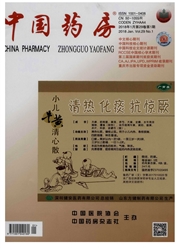

 中文摘要:
中文摘要:
目的:探讨麻黄汤的发汗作用机制与M受体的关系。方法:将70只小鼠随机分为麻黄汤+硫酸阿搀品注射液0.1mg/kg组、麻黄汤+硫酸阿托品注射液o.4mg/kg组、硫酸阿托品注射液0.1mg/kg+麻黄汤组、硫酸阿托品注射液0.4mg/kg+麻黄汤组、麻黄汤组、硫酸阿托品注射液0.1mg/kg组、空白对照(生理盐水)组,给药后30min,采用组织形态学方法观察小鼠腋窝部皮肤汗腺组织,以判断其发汗作用强弱。结果:麻黄汤具有发汗作用,阿托品对麻黄汤的发汗作用有抑制作用,但不能完全阻滞,随着阿托品剂量增加,发汗作用减弱;麻黄汤+阿托品组的发汗作用强于阿托品+麻黄汤组。结论:麻黄汤发汗作用与激动M受体有关,但并非唯一途径。
 英文摘要:
英文摘要:
OBJECTIVE: To study the diaphoretic mechanisms of Mahuangtang and its relationship with M receptor. METHODS: 70 mice were randomized into 7 groups, which were treated with Mahuangtang plus atropine sulfate injection (0. 1mg/kg), Mahuangtang plus atropine sulfate injection (0.4mg/kg), atropine sulfate injection (0. 1mg/kg) plus Mahuangtang, atropine sulfate injection (0.4mg/ kg) plus Mahuangtang, Mahuangtang, atropine sulfate injection (0.1mg/ kg) and control group (physiologic saline) . The sweet gland on axillary fossa was observed by histomorphologic methods to assess its diaphoretic function 30 min after drug administration. RESULTS: Mahuangtang was effective for the diaphoresis, while atropine had inhibitory action on its diaphoretic function, but can not eliminate it completely. As the atropine dosage increased, the diaphoretic function of Mahuangtang became weaker. The diaphoretic function of Mahuangtang plus atropine group was stronger than that of atropine plus Mahuangtang group. CONCLUSIONS: The diaphortic function of Mahuangtang was relative to activating M receptor, but wasn't an only approach.
 同期刊论文项目
同期刊论文项目
 同项目期刊论文
同项目期刊论文
 期刊信息
期刊信息
